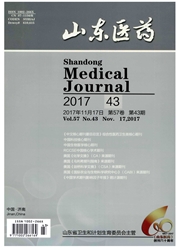

 中文摘要:
中文摘要:
①目的研究在体外条件下地塞米松及骨髓细胞对肺组织细胞的影响。②方法取小鼠肺组织细胞体外培养,通过脂多糖(LPS,10μg/mL)刺激建立肺组织损伤模型,给予骨髓细胞(5×10^6)及经过不同浓度地塞米松(2ng/mL,4ng/mL,10ng/mL,1μg/mL)处理的骨髓细胞(5×10^6)进行处理,5天后检测各组细胞的形态及凋亡情况。再通过LPS滴鼻制作急性肺损伤小鼠模型(50μg/只),再分别给予回输生理盐水、地塞米松、荧光骨髓细胞、地塞米松和荧光骨髓细胞,比较各组死亡率。③结果与单纯肺组织细胞组相比,其他各实验组细胞的形态均较好,凋亡率均较低,其中同时给予地塞米松2ng/mL处理的骨髓细胞实验组的细胞数量最多,形态最好,凋亡率最低(P〈0.05);给予地塞米松和荧光骨髓细胞处理的实验组小鼠死亡率最低(P=0.034)。④结论在体外培养条件下,地塞米松2ng/mL可以加强骨髓细胞对损伤肺组织的保护作用,维持肺组织细胞的形态,降低肺组织细胞的凋亡。
 英文摘要:
英文摘要:
Objective To study the effects of dexamethasone and bone marrow cells on lung tis- sue in vitro. Methods Mouse lung tissue cells were cultured in vitro, Bone marrow cells (5 X 106) treated with different concentrations of dexamethasone (2ng/mL, 4ng/mL, 10ng/mL, 1μg/mL) were treated with lipopolysaccharide (LPS, 10μg/mL) to induce lung injury model. And the morphology and apoptosis of the cells were detected after 5 days. And then made LPS intranasal acute lung injury model (50μg/only). Then the rats were treated with normal saline, dexamethasone, fluorescent bone marrow cells, dexamethasone and fluorescent bone marrow cells. The mortality of each group was compared. Results Compared with the pure lung cell group, the other groups had good cell morphology, apoptosis rate was low, while dexamethasone treatment 2ng/mL number of bone marrow cells in the experimental group were the most and best form, and the apoptosis rate of the lowest (P〈0.05) ; and at the same time,dexamethasone and fluorescence of bone marrow cells in the experimental group the lowest mortality (P = 0.034). Conclusion In vitro culture, dexamethasone 2ng/mL can enhance the protective effect of bone marrow cells on damaged lung tissue,maintain the morphology of lung cells and reduce the apoptosis of lung tissue cells.
 同期刊论文项目
同期刊论文项目
 同项目期刊论文
同项目期刊论文
 期刊信息
期刊信息
